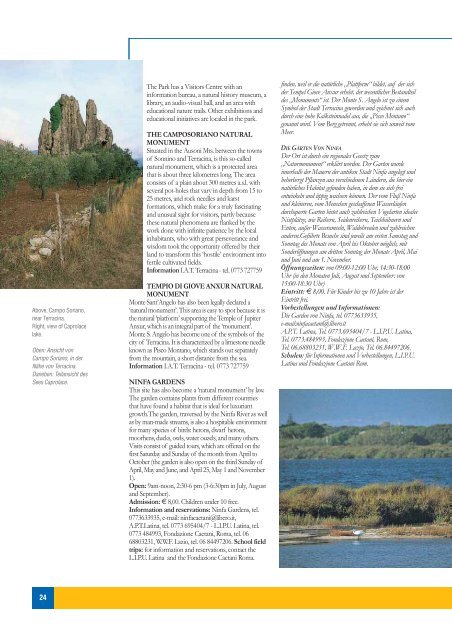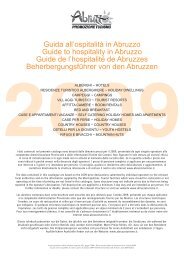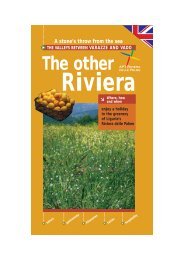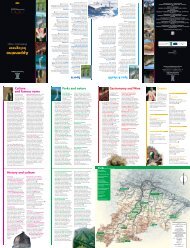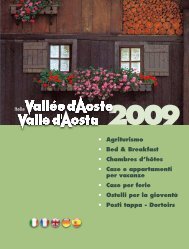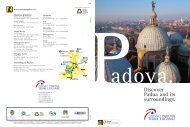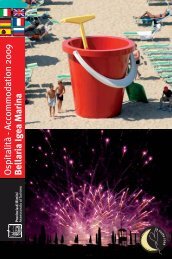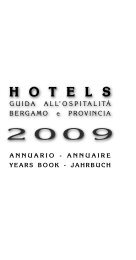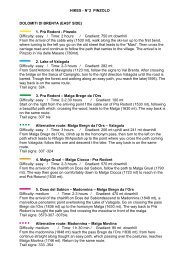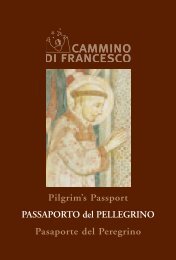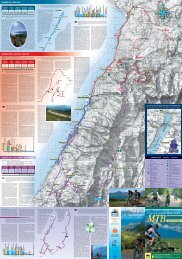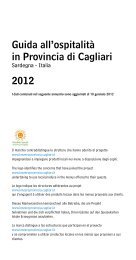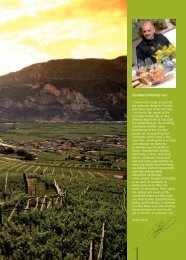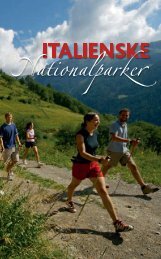Create successful ePaper yourself
Turn your PDF publications into a flip-book with our unique Google optimized e-Paper software.
Above, Campo Soriano,<br />
near Terracina.<br />
Right, view of Caprolace<br />
lake.<br />
Oben: Ansicht von<br />
Campo Soriano, in der<br />
Nähe von Terracina.<br />
Daneben: Teilansicht des<br />
Sees Caprolace.<br />
24<br />
The Park has a Visitors Centre with an<br />
information bureau, a natural history museum, a<br />
library, an audio-visual hall, and an area with<br />
educational nature trails. Other exhibitions and<br />
educational initiatives are localed in the park.<br />
THE CAMPOSORIANO NATURAL<br />
MONUMENT<br />
Situated in the Ausoni Mts. between the towns<br />
of Sonnino and Terracina, is this so-called<br />
natural monument, which is a protected area<br />
that is about three kilometres long. The area<br />
consists of a plain about 300 metres a.s.l. with<br />
several pot-holes that vary in depth from 15 to<br />
25 metres, and rock needles and karst<br />
formations, which make for a truly fascinating<br />
and unusual sight for visitors, partly because<br />
these natural phenomena are flanked by the<br />
work done with infinite patience by the local<br />
inhabitants, who with great perseverance and<br />
wisdom took the opportunity offered by their<br />
land to transform this ‘hostile’ environment into<br />
fertile cultivated fields.<br />
Information I.A.T. Terracina - tel. 0773 727759<br />
TEMPIO DI GIOVE ANXUR NATURAL<br />
MONUMENT<br />
Monte Sant’Angelo has also been legally declared a<br />
‘natural monument’. This area is easy to spot because it is<br />
the natural ‘platform’ supporting the Temple of Jupiter<br />
Anxur, which is an integral part of the ‘monument’.<br />
Monte S. Angelo has become one of the symbols of the<br />
city of Terracina. It is characterized by a limestone needle<br />
known as Pisco Montano, which stands out separately<br />
from the mountain, a short distance from the sea.<br />
Information I.A.T. Terracina - tel. 0773 727759<br />
NINFA GARDENS<br />
This site has also become a ‘natural monument’ by law.<br />
The garden contains plants from different countries<br />
that have found a habitat that is ideal for luxuriant<br />
growth.The garden, traversed by the Ninfa River as well<br />
as by man-made streams, is also a hospitable environment<br />
for many species of birds: herons, dwarf herons,<br />
moorhens, ducks, owls, water ouzels, and many others.<br />
Visits consist of guided tours, which are offered on the<br />
first Saturday and Sunday of the month from April to<br />
October (the garden is also open on the third Sunday of<br />
April, May and June, and April 25, May 1 and November<br />
1).<br />
Open: 9am-noon, 2:30-6 pm (3-6:30pm in July, August<br />
and September).<br />
Admission: € 8,00. Children under 10 free.<br />
Information and reservations: Ninfa Gardens, tel.<br />
0773633935, e-mail: ninfacaetani@libero.it,<br />
A.P.T.<strong>Latina</strong>, tel. 0773 695404/7 - L.I.P.U. <strong>Latina</strong>, tel.<br />
0773 484993, Fondazione Caetani, Roma, tel. 06<br />
68803231, W.W.F. Lazio, tel. 06 84497206. School field<br />
trips: for information and reservations, contact the<br />
L.I.P.U. <strong>Latina</strong> and the Fondazione Caetani Roma.<br />
finden, weil er die natürliche „Plattform“ bildet, auf der sich<br />
der Tempel Giove Anxur erhebt, der wesentlicher Bestandteil<br />
des „Monuments“ ist. Der Monte S. Angelo ist zu einem<br />
Symbol der Stadt Terracina geworden und zeichnet sich auch<br />
durch eine hohe Kalksteinnadel aus, die „Pisco Montano“<br />
genannt wird. Vom Berg getrennt, erhebt sie sich unweit vom<br />
<strong>Meer</strong>.<br />
DIE GÄRTEN VON NINFA<br />
Der Ort ist durch ein regionales Gesetz zum<br />
„Naturmonument“ erklärt worden. Der Garten wurde<br />
innerhalb der Mauern der antiken Stadt Ninfa angelegt und<br />
beherbergt Pflanzen aus verschiedenen Ländern, die hier ein<br />
natürliches Habitat gefunden haben, in dem sie sich frei<br />
entwickeln und üppig wachsen können. Der vom Fluß Ninfa<br />
und kleineren, vom Menschen geschaffenen Wasserläufen<br />
durchquerte Garten bietet auch zahlreichen Vogelarten idealee<br />
Nistplätze, wie Reihern, Seidenreihern, Teichhühnern und<br />
Enten, außer Wasseramseln, Waldohreulen und zahlreichen<br />
anderen.Geführte Besuche sind jeweils am ersten Samstag und<br />
Sonntag des Monats von April bis Oktober möglich, mit<br />
Sonderöffnungen am dritten Sonntag der Monate April, Mai<br />
und Juni und am 1. November.<br />
Öffnungszeiten: von 09:00-12:00 Uhr, 14:30-18:00<br />
Uhr (in den Monaten Juli, August und September: von<br />
15:00-18:30 Uhr)<br />
Eintritt: € 8,00. Für Kinder bis zu 10 Jahre ist der<br />
Eintritt frei.<br />
Vorbestellungen und Informationen:<br />
Die Garden von Ninfa, tel. 0773633935,<br />
e-mail:ninfacaetani@libero.it<br />
A.P.T. <strong>Latina</strong>, Tel. 0773.695404/7 - L.I.P.U. <strong>Latina</strong>,<br />
Tel. 0773.484993, Fondazione Caetani, Rom,<br />
Tel. 06.68803231, W.W.F. Lazio, Tel. 06.84497206.<br />
Schulen: für Informationen und Vorbestellungen, L.I.P.U.<br />
<strong>Latina</strong> und Fondazione Caetani Rom.


